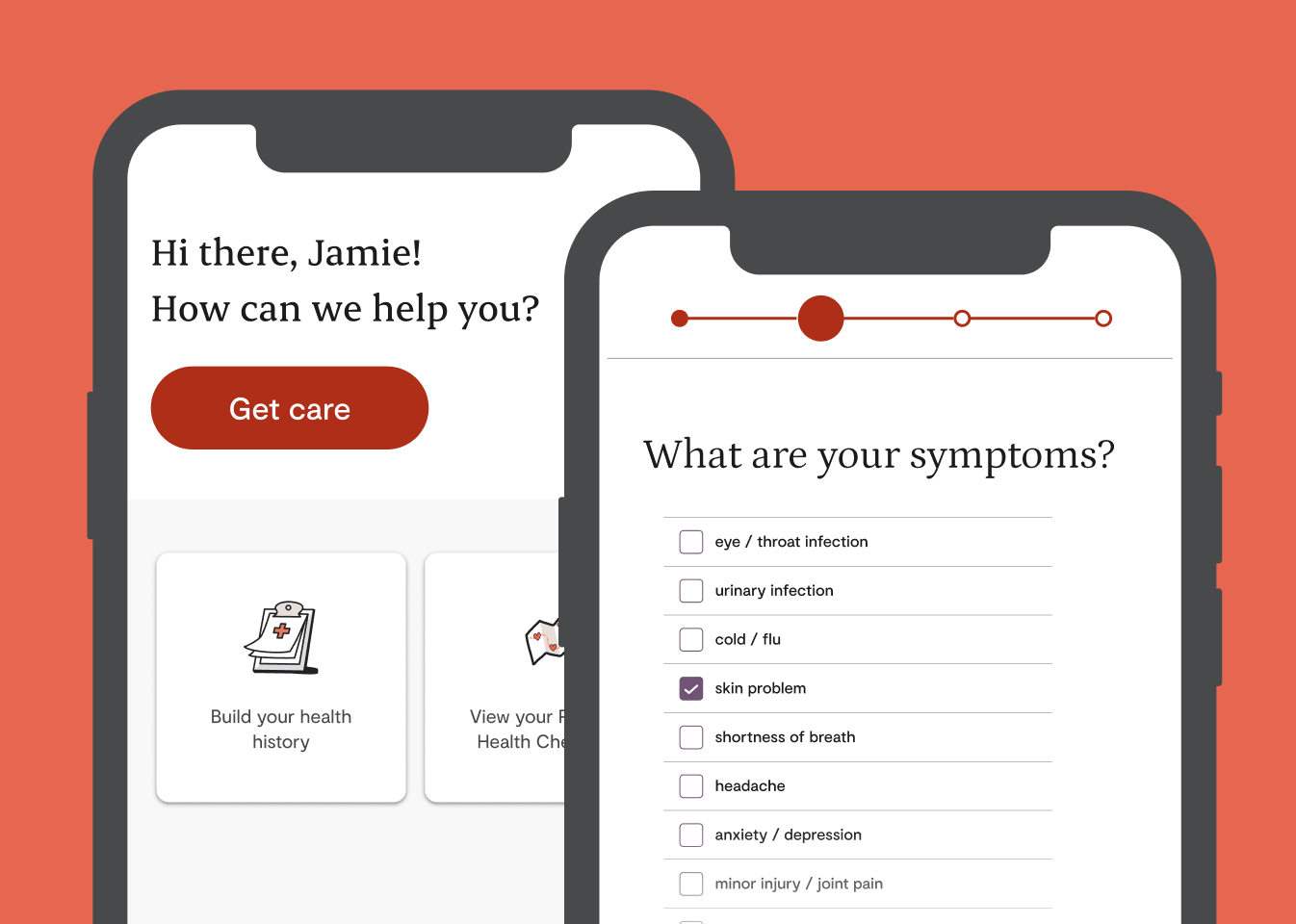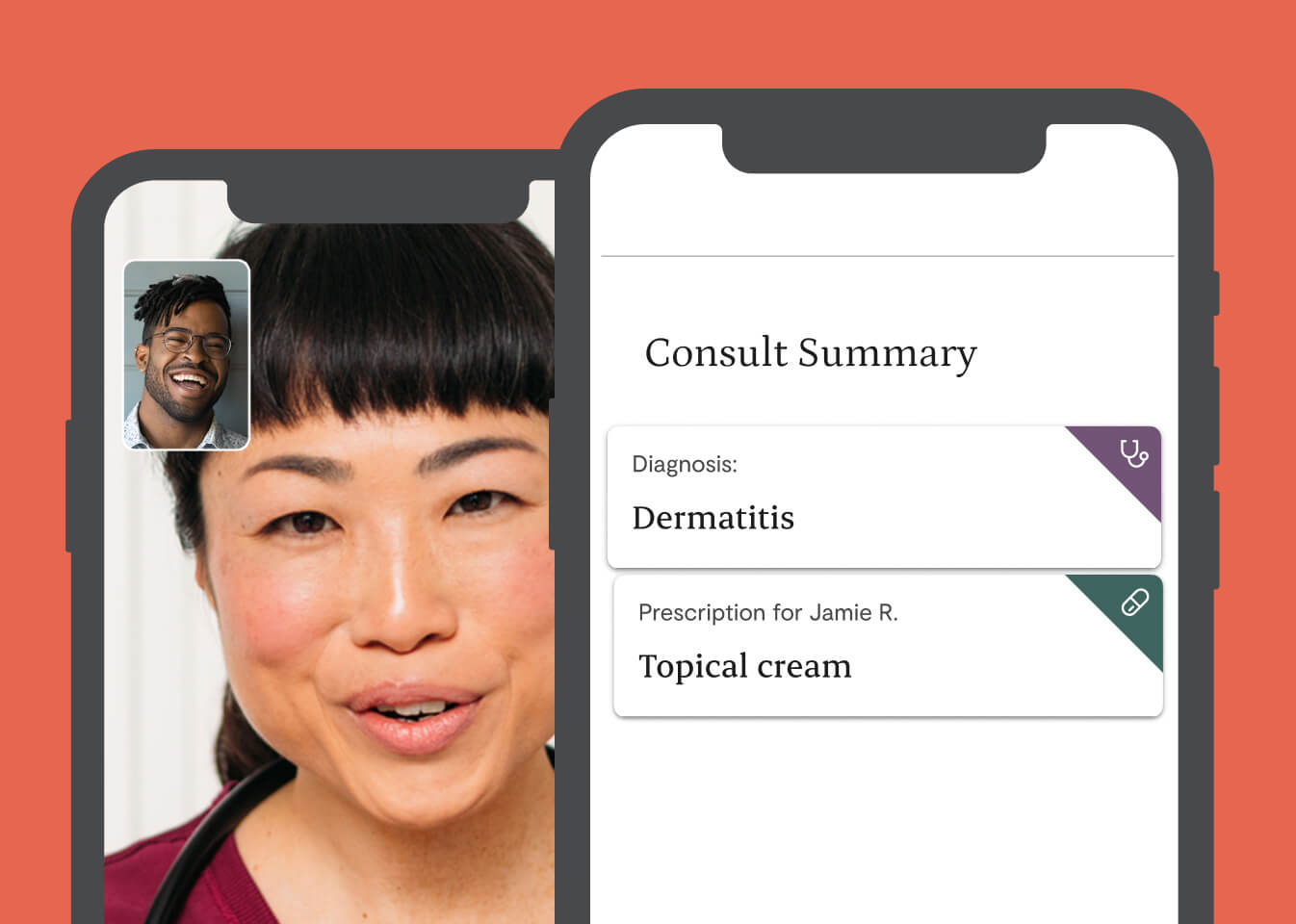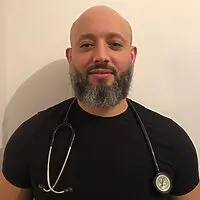Hair loss (alopecia) treatment, diagnosis & prescriptions
Skip the waiting room! Instantly connect with Canadian doctors for medical care from your phone, tablet or computer - any time, 24/7.

- Prescriptions available at a provider's discretion
- Speak to a doctor or nurse practitioner
- 24/7 availability
- Get connected in minutes
Trusted by millions of Canadians
- 4.8 rating30K+ App Store reviews
- 4.6 score5K+ Trustpilot reviews
Talk to a doctor about hair loss (alopecia) treatment online
See a doctor or nurse practitioner today to get a new prescription or refill, at their discretion.
See a provider in three easy steps.
- 1
Register and become a member

- 2
Select the “Get care” button on our homepage

- 3
Connect with a Canadian-licensed doctor or nurse practitioner in minutes

Why Canadians love Maple
A fantastic way to get medical advice when you are unable to see someone in person. The app is so simple to use. Highly recommend. I am not a tech savvy person but the doctor was kind enough to patiently walk me through every step of the process. Thank you.
Saved me hours waiting in the ER.
Fast and effective tool for getting a diagnosis and prescription.
The doctor willingly took the time to explain things to me.
Very easy to book a therapist and get appointment receipts.
Frequently asked questions
About Hair loss (Alopecia)
Yes, you can. The doctor will want to give you a physical exam, and discuss any symptoms or signs of alopecia that you’re experiencing. They’ll also want to discuss your personal and family medical histories.
Before providing a diagnosis for alopecia, the healthcare professional may suggest additional tests to ensure your alopecia isn’t being caused by other underlying conditions.
Once you have a clear alopecia diagnosis, the healthcare provider can suggest appropriate treatments for your alopecia.
Yes, our physicians can prescribe alopecia medications online during your consultation. Once you accept a prescription for alopecia, you’ll have the option to pick it up from any pharmacy or to have it delivered right to your door at no additional cost.
Most people lose between 50 to 100 hairs per day. This is normal, and is not usually noticeable because new hair is growing in at the same time to replace the ones that are lost. However, when it doesn’t grow back in, you may be experiencing alopecia symptoms.
Alopecia areata, also known as hair loss or simply alopecia, is a common autoimmune disorder that causes hair to fall out. Sometimes the hair grows back, but falls out again later. In other cases, the hair may never grow back, or grow back for good once it returns.
The main symptom or sign of alopecia is hair loss. What differs is the pattern and speed of hair loss, exclamation point hairs, and nail involvement, This can appear as:
- Sudden or gradual loosening of hair
- Full-body hair loss
- More hair loss during cold seasons
- Quarter-sized, circular, or patchy bald spots
- Hair thinning on the top of the head
- Scaling that is spread across the scalp
- Patches growing together into larger bald spots
You may notice a tingling, itching, or burning sensation on the skin around the hair follicles, right before the hair falls out. The skin is left smooth, with no redness or rashes.
Also, less commonly, alopecia can cause fingernails and toenails to become brittle, red, and pitted.
Alopecia is caused by white blood cells attacking the cells in hair follicles. This causes them to shrink, as well as slow down hair production. The exact cause for alopecia’s immune response isn’t known at this time.
However, there are some risk factors that can increase your chances of experiencing some form of alopecia. These include:
- Hormonal changes (thyroid problems, menopause, pregnancy, etc.)
- Family history of alopecia
- Extreme stress
- Certain medical conditions (diabetes, lupus, etc.)
- Significant weight loss
- Poor nutrition
- Medications or supplements
- Certain hairstyles or hair treatments
- Radiation therapy to the head
- Low vitamin D levels
Before offering a diagnosis for alopecia, the healthcare provider will want to discuss your personal and family medical histories. They’ll also want to discuss any symptoms or signs of alopecia you’re experiencing and perform a physical exam. The healthcare provider may also ask you questions about your hair care routine or your diet.
In some cases, the healthcare provider may suggest additional testing like blood tests or a scalp biopsy, to check for underlying conditions or infections that can cause alopecia.
They may also do a pull test, which involves gently pulling on several dozen hairs, to see how many come out. This procedure will help the doctor determine the severity of your alopecia.
Less frequently, the healthcare provider may suggest light microscopy to check for disorders of the hair shaft.
Once there is a clear diagnosis for alopecia, your healthcare provider will suggest appropriate alopecia treatments, depending on the severity of your condition.
There are some effective alopecia treatments for certain types of hair loss. In some cases, you may be able to reverse hair loss or at least slow it. Some forms of hair loss may regrow within a year, without any alopecia treatments. However, some forms of alopecia can’t be reversed, and the hair loss may become permanent.
If your alopecia is being caused by an underlying condition, treating that condition could help reduce alopecia symptoms. If your alopecia is being caused by certain medications, the healthcare provider may change or temporarily stop your prescription.
In some cases, the healthcare provider may suggest prescription alopecia medications to help treat pattern baldness.
Less frequently, the healthcare provider may suggest hair transplant surgery or laser therapy as alopecia treatments. However, these alopecia treatments may not be effective, and even if they are successful, may not provide long-term solutions.
If you’ve begun to lose your hair, you should talk to a healthcare provider. Certain underlying conditions can cause alopecia, and may need to be treated to reduce alopecia symptoms.
A healthcare provider from Maple will be able to help provide you with a clear alopecia diagnosis. This way, you can find the treatments that will work best for you. This includes any prescription alopecia medications that may be necessary.
Don’t be embarrassed about losing your hair. Talk to a healthcare provider from Maple, and they’ll be able to help you manage any signs of alopecia you’re experiencing.
Maple 101
Maple is a virtual care platform that connects you with doctors and other healthcare providers via text, audio, or video. After you log in to your Maple account, you can request an online consultation.
Consultations work similarly to in-person appointments — the doctor can complete an assessment by asking questions about your symptoms, going through your health history, and determining what treatment is right for you. If they think your condition is more serious, they may tell you to go to a clinic for an in-person examination.
As a Maple member, you get 24/7 access to virtual primary care online and more. You can connect with our network of providers via text, audio, or video call within minutes.
Pricing and Payment
Our membership costs $79.99/month and covers virtual care for patients and their families, including the primary account holder's spouse and any dependents.
For patients in eligible provinces, our membership includes:
- Access to daily primary care provider visits: One daily visit with a primary care provider for each family member in their household.
- Paediatric care: Covered paediatric primary care visits, available by appointment.
- Second medical opinions: access to a network of experts for a second opinion if diagnosed with a complex condition (e.g. cancer).
- Personal Health Check-Ins: A series of personalized, evidence-based proactive care screenings to maintain and improve health.
- iCBT courses: Access to iCBT (internet-based cognitive behavioural therapy) self-assessment and courses.
- Access to specialists in eligible provinces: Easy access to specialists on Maple within days, not months. No referral is needed.
- Specialist referrals in eligible provinces: Ability to be referred to a physician specialist for in-person care, if needed.
- Credit discounts: An $80 credit per month to be applied to a Maple specialist visit.
Please note that our membership cannot be combined with other offerings, such as private insurance coverage and provincial programs, where available. In some cases, membership fees can be covered by a Healthcare Spending Account (HSA) — check with your HSA provider for more details.
We accept all major credit cards, including AMEX cards, as well as Google and Apple Pay.
Security and Privacy
At Maple, we proudly prioritize privacy as a cornerstone of our virtual care services. We strictly adhere to privacy and healthcare legislation in Canada, such as PIPEDA and PHIPA regulations, to ensure patients' personal and health information remains completely private and safeguarded.
Our policies and consent processes are designed to be simple and easily understood, empowering individuals with control and a clear understanding of their healthcare journey. When using our services, a patient’s session is protected by a comprehensive security infrastructure and stringent data policies.
Patients also retain full control of their personal health information, medical records and test results at all times. Our approach is reinforced by consultations with leading experts, guaranteeing comprehensive policy frameworks that are reviewed at a regular cadence.
All providers delivering healthcare through Maple are licensed in Canada and governed by their licensing regulatory colleges, and in all instances, must act in accordance with the governing principles set out in the telemedicine policies of each medical regulator in the applicable province.
Regulators across Canada support and recognize the value of services like ours, and the way in which they can benefit patients, physicians, and Canada’s broader healthcare system by improving access to care and increasing efficiencies in the delivery of care.
Do you need medical care today?
Trusted, experienced doctors and nurse practitioners are ready to see you.
Maple is safe and effective for common non-emergency issues. If you believe you are experiencing an emergency, please call 911 or proceed to your nearest emergency room.










